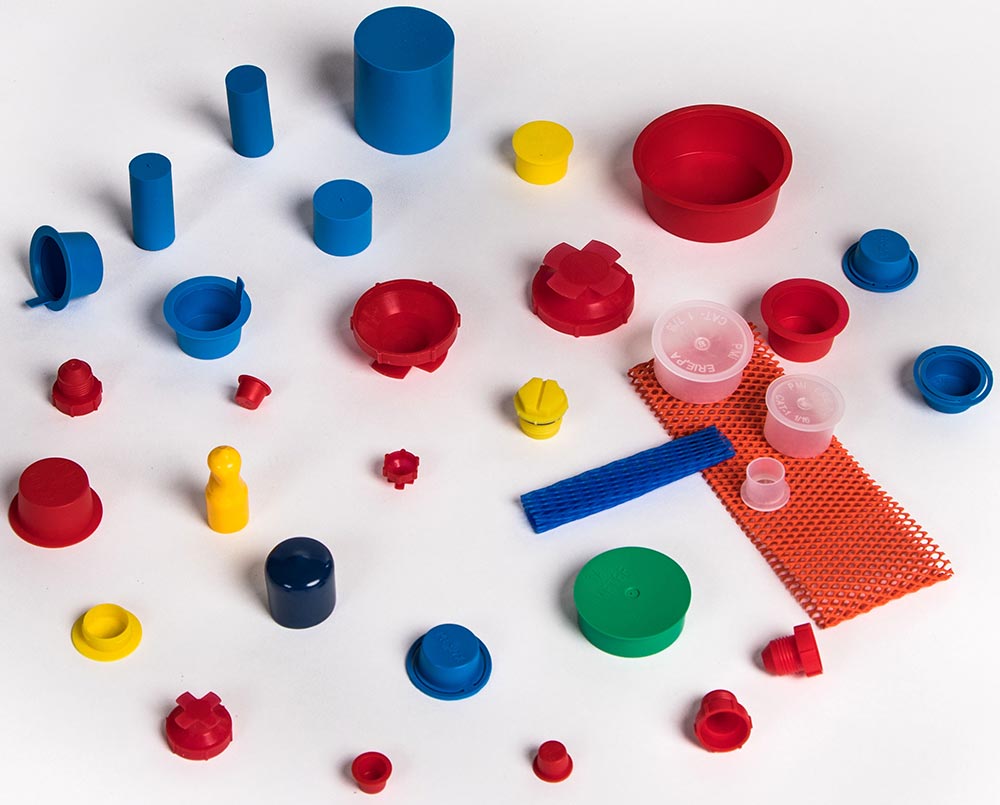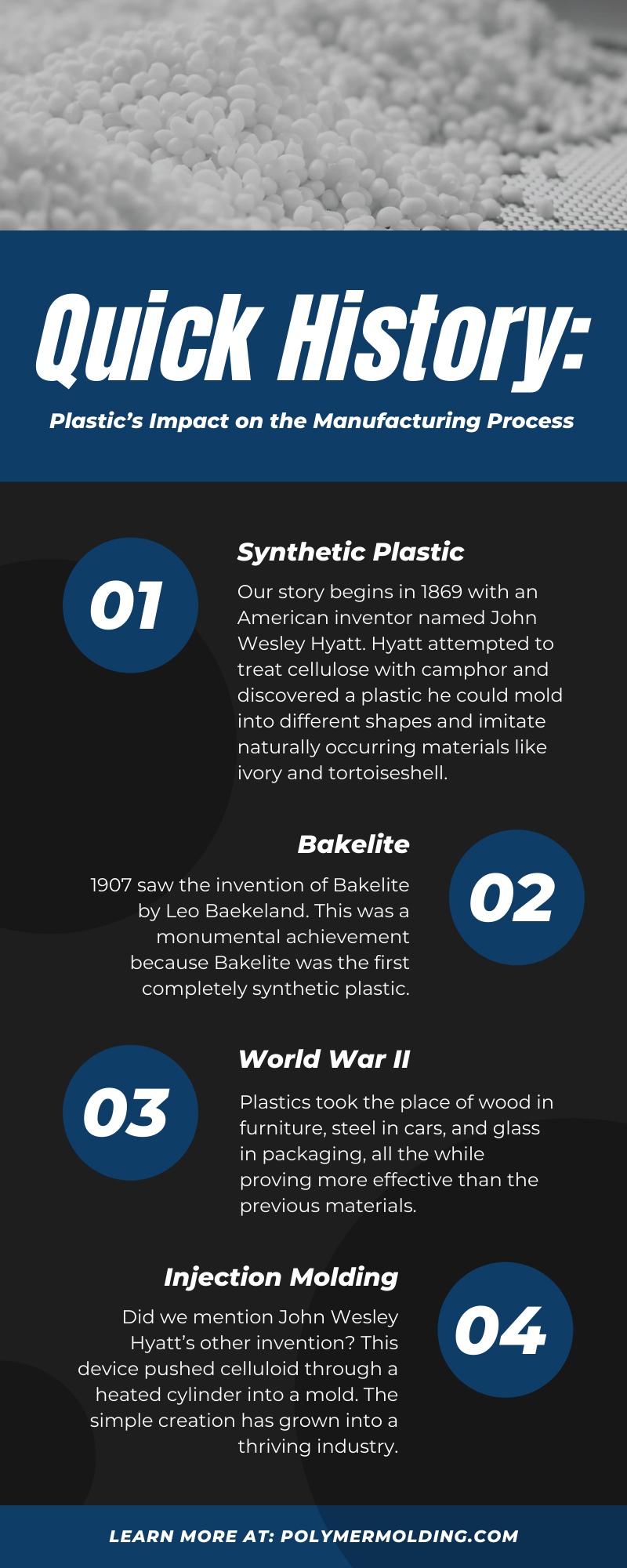News & Events


Quick History: Plastic’s Impact on the Manufacturing Process
Plastic was once nothing more than a word meaning “pliable and easily shaped.” While polymers have always been abundant in nature, it is far more recent that “plastic” became a stand-in for this type of material.
Polymer, meaning “of many parts,” refers only to naturally occurring or artificial materials. We’ve broken down a quick history of plastic’s impact on the manufacturing process, so read on to learn the evolution of this essential substance.
What Are Plastics?
Plastics are vital for everyday life. Whether you started your day with television, a trip in a bus, or a ride on a train, you’ve already benefitted from plastics. Before humans manufactured plastics, all the building blocks were available in nature. Natural gas, plants, and coal all contain organic polymers.
Plastics are straightforward. You’ve probably heard of plastics that start with the prefix “poly” before, including polypropylene, polyethylene, and polystyrene. They get their names because molecules link together to form chains called “polymers.”
Where Do Plastics Come From?
Our manufactured plastics wouldn’t be nearly as advanced without the polymers in nature. Synthetic polymers use natural molecular chains as jumping-off points, typically extending the chain to make synthetic polymers stronger and more flexible.
If you look back to the beginning of the 19th century, you’d see zero synthetic polymers in use. Today, we can hardly manage without them! Their development caused an incredible evolution in daily life.
Synthetic Plastic
Our story begins in 1869 with an American inventor named John Wesley Hyatt. A firm in New York offered $10,000 to anyone who could invent a synthetic substitute for ivory to, among other things, develop billiard balls. Since the mass production of billiard balls led to the creation of modern plastics, the plastics industry owes its success to the game.
Hyatt attempted to treat cellulose with camphor and discovered a plastic he could mold into different shapes and imitate naturally occurring materials like ivory and tortoiseshell. While nature only had so much ivory to offer, now constraints disappeared, and with them the need to kill elephants and tortoises. This was only the beginning.
Bakelite
1907 saw the invention of Bakelite by Leo Baekeland. This was a monumental achievement because Bakelite was the first completely synthetic plastic. Baekeland found an artificial substitute for shellac with no natural molecules that could act as a heat-resistant, durable insulator.
Baekeland and Hyatt’s discoveries prompted chemical companies to invest huge sums in the development of new polymers, as they (correctly) assumed there was more plastic had to offer. Baekeland and Hyatt had gone looking for plastics with specific properties but then began the age of researching new materials for their own sake.
World War II
Industrial might was one of the many keys to victory in World War II. Who knows what would have happened if America did not develop its plastics. War is devastating to so many aspects of life, but many people forget how taxing it is on natural resources. That’s how synthetic resources helped push the Allies to victory!
You may think of nylon as the material that makes pantyhose, but did you know it was used in World War II to create ropes, body armor, and parachutes? Additionally, you can thank plexiglass for many airplane windows during this period. Glass was too expensive, so we needed a synthetic option.
Plastic did not disappear when the war ended—quite the opposite, in fact! Plastics took the place of wood in furniture, steel in cars, and glass in packaging, all the while proving more effective than the previous materials.
Injection Molding
Did we mention John Wesley Hyatt’s other invention? As if creating celluloid wasn’t enough, Hyatt and his brother Isaiah also patented the world’s first injection molding machine. This device pushed celluloid through a heated cylinder into a mold. The simple creation has grown into a thriving industry.
Today, injection molding can create anything from simple spheres (like the billiard balls of Hyatt’s day) to complicated pieces used in machines. In addition, we are no longer limited to celluloid as our material. High-density polyethylene, polystyrene, and polycarbonate are just a few of the options at our fingertips.
If you’re in the market for a plastic plug manufacturer that can get you the finishing products you need, Polymer Molding can help.
Plastic Concerns
While the benefits of plastics are great, nothing is perfect. The 1960s saw the discovery of plastic debris in the oceans, and it’s no secret that plastic litter can harm wildlife. Luckily, many plastic manufacturers addressed these concerns head-on, changing their practices to ensure they produce as little waste as possible.
We’d also like to address an assumption that grew in this period: that all plastic products are cheap. While there are certainly plastics with less tensile strength than others, there are also polymers with incredible strength and quality.
People tend to assume that there must be something wrong with plastics since they’re so much cheaper and easier to produce than other materials. In truth, plastics are simply an incredibly versatile, efficient invention!
The Future of Plastics
Modern life and plastics are intrinsically linked. If all plastics suddenly disappeared, day-to-day life would stop functioning. Without plastics, you can kiss your refrigerator, cell phone, and even modern medicine goodbye!
Where do plastics go from here? Scientists and researchers worldwide are committed to making plastics more sustainable. There have already been incredible breakthroughs in biodegradable plastics to circumvent the possibility of people littering. Scientists have even developed plastics made of plant crops instead of fossil fuels!
While we can’t predict the future, we can say with certainty that the next generation of plastics will incorporate all the most essential attributes: strength, ease-of production, and sustainability.
Now that you know a quick history of plastic and its importance in the manufacturing process, consider incorporating these versatile materials into your next project. Plastic can do anything you need it to!


